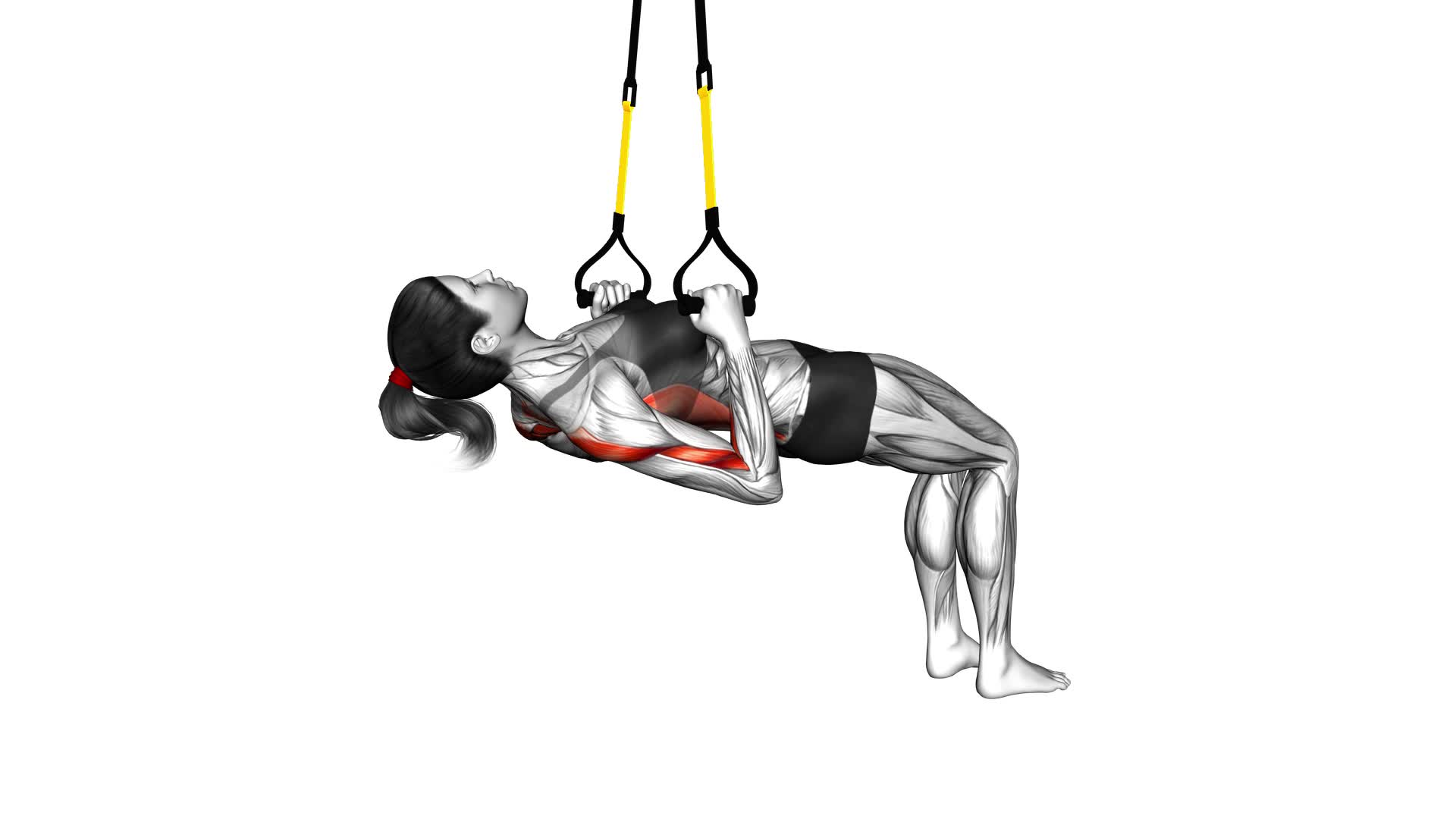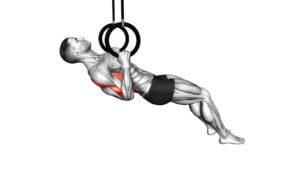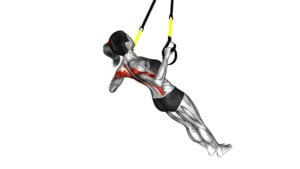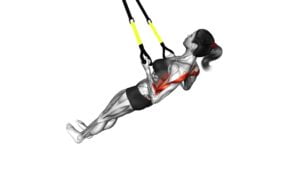Suspender Bent Knee Inverted Row (Female) – Video Exercise Guide & Tips

Are you looking for a challenging upper body exercise that targets your back muscles? Look no further than the Suspender Bent Knee Inverted Row.
Watch This Exercise Video
In this video exercise guide, we'll show you the proper form and technique, as well as variations to make it more challenging.
Plus, we'll help you avoid common mistakes and give you tips for incorporating this exercise into your workout routine.
Get ready to strengthen and tone your back like never before!
Key Takeaways
- The Suspender Bent Knee Inverted Row targets back muscles, specifically the lats.
- It improves posture and develops a strong and defined back.
- The exercise works biceps, shoulders, and core for a full-body workout.
- The exercise offers versatility with variations to continuously progress and prevent plateauing in your fitness journey.
Benefits of the Suspender Bent Knee Inverted Row
Discover the benefits you can reap from performing the Suspender Bent Knee Inverted Row. This exercise offers numerous advantages for your overall fitness and strength training routine.
One of the key benefits of the Suspender Bent Knee Inverted Row is that it targets your back muscles, specifically the lats. By engaging these muscles, you can improve your posture and develop a strong and defined back. Additionally, this exercise also works your biceps, shoulders, and core, providing a full-body workout.
Another benefit of the Suspender Bent Knee Inverted Row is its versatility. There are several variations you can incorporate to challenge yourself and keep your workouts interesting. For instance, you can increase the difficulty by performing the exercise with one leg elevated or by using a wider grip. This allows you to continuously progress and prevent plateauing in your fitness journey.
As you can see, the Suspender Bent Knee Inverted Row offers numerous benefits for your overall fitness and strength. Now, let's move on to the equipment needed for this exercise, so you can start incorporating it into your workout routine.
Equipment Needed for the Exercise
To perform the Suspender Bent Knee Inverted Row, you'll need a few pieces of equipment. Here are the items you'll require:
- Suspension straps: These are the main equipment for this exercise. They consist of adjustable straps with handles that can be anchored to a sturdy structure, such as a pull-up bar or a power rack.
- Suspension anchor: You'll need a secure anchor point to attach the suspension straps. It can be a door frame attachment or a ceiling mount, as long as it can support your body weight.
- Knee pads: Since you'll be performing the exercise with bent knees, it's advisable to use knee pads to provide extra cushioning and protect your knees from potential discomfort or injuries.
- Exercise mat: It's recommended to use an exercise mat to provide a comfortable surface for your hands and knees during the exercise.
If you don't have access to suspension straps or prefer not to use them, there are alternative options for performing row exercises. You can use a barbell and perform bent-over rows, or use dumbbells and perform bent-over rows or single-arm rows. These exercises target similar muscles and can be effective alternatives to the Suspender Bent Knee Inverted Row.
Proper Form and Technique
To perform the Suspender Bent Knee Inverted Row with proper form and technique, there are three key points to focus on.
First, maintaining proper body alignment is crucial to prevent injury and maximize the effectiveness of the exercise.
Second, engaging your core muscles throughout the movement will help you maintain stability and control.
Finally, it's important to be aware of common mistakes and avoid them, such as using momentum or arching your back.
Body Alignment Importance
Your body's alignment is crucial to ensure proper form and technique during the Suspender Bent Knee Inverted Row exercise. Paying attention to your body posture and muscle activation will help you maximize the benefits of this exercise and prevent injuries.
Here are some key points to keep in mind:
- Start by lying flat on your back with your knees bent and feet flat on the ground.
- Keep your spine in a neutral position, avoiding excessive arching or rounding of the back.
- Engage your core muscles by pulling your belly button towards your spine.
- Maintain a straight line from your head to your heels throughout the exercise.
By maintaining proper body alignment, you'll be able to effectively target your back muscles, improve your posture, and increase overall strength.
Engaging Core Muscles
Now, focus on engaging your core muscles to maintain proper form and technique during the Suspender Bent Knee Inverted Row exercise. Engaging your core muscles is crucial as it helps stabilize your body and protect your spine during the movement.
By actively contracting your core, you create a solid foundation for the exercise, which allows you to generate more power and strength. Not only does engaging your core muscles improve your performance, but it also offers numerous benefits of core strengthening.
These include improved posture, enhanced balance and stability, reduced risk of lower back pain, and increased overall functional strength.
Avoiding Common Mistakes
Maintain proper form and technique during the Suspender Bent Knee Inverted Row exercise to avoid common mistakes. By following these guidelines, you can minimize the risk of injury and maximize the effectiveness of the exercise:
- Keep your body in a straight line from head to toe, avoiding any sagging or arching of the back.
- Engage your core muscles throughout the movement to provide stability and support.
- Avoid pulling with your neck or using excessive momentum to complete the exercise.
- Modify the exercise if needed by adjusting the height of the suspension straps or bending your knees to reduce the intensity.
By focusing on maintaining proper form and technique, you can ensure that you're targeting the intended muscles and avoiding unnecessary strain.
Now, let's explore some variations to make the exercise more challenging.
Variations to Make the Exercise More Challenging
To increase the difficulty of the Suspender Bent Knee Inverted Row exercise, try incorporating advanced variations. These advanced modifications will challenge your muscles even more and help you continue to progress in your fitness journey.
One way to increase resistance is by using a resistance band. Simply loop the band around the handles of the suspension trainer and then place your feet inside the band. This will add extra resistance to the exercise, making it more challenging for your upper body muscles.
Another way to make the exercise more challenging is by adjusting the angle of your body. Instead of keeping your body straight, try elevating your feet on a bench or step. This will increase the amount of bodyweight you have to lift, putting more strain on your muscles.
Additionally, you can try performing the exercise with one leg raised off the ground. This won't only challenge your upper body, but also engage your core and stability muscles.
Incorporating these advanced variations will help you push your limits and continue to make progress in your strength training. Remember to always listen to your body and only attempt these modifications if you feel comfortable and confident in your abilities.
Common Mistakes to Avoid
To ensure proper execution of the Suspender Bent Knee Inverted Row, there are a few common mistakes you should avoid.
Firstly, make sure you have the correct grip position, as an incorrect grip can compromise your form and limit the effectiveness of the exercise.
Additionally, it's important to engage your core throughout the movement to maintain stability and prevent strain on your lower back.
Lastly, improper body alignment, such as arching your back or letting your shoulders hunch forward, can also hinder your progress.
Incorrect Grip Position
Are you gripping the suspension straps correctly during the Suspender Bent Knee Inverted Row exercise? Improper hand placement can lead to potential risks and reduce the effectiveness of the exercise. Here are some common mistakes to avoid when it comes to grip position:
- Holding the straps too tightly: This can cause unnecessary tension in your hands and forearms, making it difficult to maintain proper form.
- Placing your hands too close together: This limits your range of motion and can put excessive strain on your wrists.
- Allowing your thumbs to wrap around the straps: This can lead to a weaker grip and increase the risk of slipping.
- Not maintaining a neutral wrist position: Avoid bending your wrists excessively or letting them flop backward, as this can strain the joints and compromise your form.
Lack of Core Engagement
Avoid neglecting your core engagement during the Suspender Bent Knee Inverted Row exercise. It's crucial to understand the benefits of core engagement and the importance of core stability in this exercise.
Engaging your core muscles helps to stabilize your body and maintain proper form throughout the movement. When you neglect your core engagement, you risk placing excessive strain on your lower back and compromising your overall performance.
By actively engaging your core, you can improve your posture, increase your strength, and prevent injuries. Focus on contracting your abdominal muscles and maintaining a strong and stable core throughout the exercise.
Improper Body Alignment
Did you properly align your body during the Suspender Bent Knee Inverted Row exercise? Improper technique and body alignment can lead to injuries and diminish the effectiveness of the exercise. Here are some common mistakes to avoid for proper body alignment during this exercise:
- Head position: Avoid tucking your chin or looking up excessively. Keep your head in a neutral position to maintain proper alignment.
- Shoulder placement: Don't shrug your shoulders or let them collapse forward. Keep your shoulders down and back, engaging your shoulder blades.
- Spine alignment: Avoid arching or rounding your back. Keep your spine in a neutral position throughout the exercise.
- Hip position: Don't let your hips sag or lift too high. Maintain a straight line from your head to your heels.
By ensuring proper body alignment, you can prevent injuries and maximize the benefits of the Suspender Bent Knee Inverted Row exercise.
Now let's move on to some tips for incorporating this exercise into your workout routine.
Tips for Incorporating the Exercise Into Your Workout Routine
To optimize your workout routine, include the Suspender Bent Knee Inverted Row exercise for a challenging upper body workout. This exercise not only targets your back muscles but also engages your biceps, shoulders, and core. Here are some tips for incorporating this exercise into your routine.
First, if you find the exercise too difficult, you can modify it by using a lower suspension point. This will decrease the resistance and make it easier to perform. On the other hand, if you want to make it more challenging, you can raise the suspension point or increase the number of repetitions.
Adding the Suspender Bent Knee Inverted Row to your routine has several benefits. It helps to improve your upper body strength, especially in the back muscles. This exercise also enhances your posture by strengthening the muscles that support your spine. Additionally, it can contribute to better shoulder stability and overall upper body muscle balance.
To get the most out of this exercise, it's important to maintain proper form throughout. Keep your body straight, engage your core, and avoid swinging or using momentum to complete the movement.
Frequently Asked Questions
How Many Sets and Reps Should I Do for the Suspender Bent Knee Inverted Row?
To determine how many sets and reps you should do for the suspender bent knee inverted row, it's important to focus on your fitness goals and current fitness level.
Start with 3 sets of 10-12 reps and adjust as needed.
Proper form is crucial for this exercise, so make sure to keep your core engaged, back straight, and shoulders pulled back.
Gradually increase the intensity and challenge yourself as you progress.
Can I Do the Suspender Bent Knee Inverted Row if I Have a Back Injury?
If you have a back injury, it's important to be cautious when considering the Suspender Bent Knee Inverted Row. This exercise puts strain on the back and may not be suitable for your condition.
It's recommended to consult with a healthcare professional or a qualified trainer for modifications or alternative exercises that can help you work out without aggravating your back injury.
Safety should always be the top priority when it comes to exercising with an injury.
Is It Necessary to Wear Suspenders for This Exercise, or Can I Use Other Equipment?
You don't have to wear suspenders for the Suspender Bent Knee Inverted Row exercise. There are alternative equipment options you can use, such as resistance bands or TRX straps.
However, it's important to maintain proper form to prevent injury. Make sure to engage your core, keep your back straight, and pull your shoulder blades together while performing the exercise.
This will help you achieve the maximum benefits and minimize the risk of strain or discomfort.
Can I Use a Resistance Band Instead of Suspenders for the Bent Knee Inverted Row?
Yes, you can definitely use a resistance band instead of suspenders for the bent knee inverted row. This alternative provides similar benefits to using suspenders, such as targeting your back muscles and improving upper body strength.
The resistance band offers added versatility and allows you to adjust the difficulty level by choosing a band with different resistance levels.
Make sure to anchor the band securely and maintain proper form throughout the exercise for optimal results.
How Long Should I Rest Between Sets When Performing the Suspender Bent Knee Inverted Row?
When performing the suspender bent knee inverted row, it's important to know how long to rest between sets to maximize your results.
To determine the appropriate rest period, consider your fitness level and how you feel during the exercise.
Generally, a rest period of 1-2 minutes is recommended for this exercise. However, always listen to your body and adjust the rest periods accordingly.
Additionally, make sure to maintain proper form throughout the exercise for optimal safety and effectiveness.
Conclusion
In conclusion, the suspender bent knee inverted row is a highly effective exercise that provides numerous benefits, such as strengthening the upper body and improving posture. It requires minimal equipment, making it accessible for anyone to try.
By following proper form and technique, individuals can maximize the effectiveness of this exercise. Additionally, there are variations available to increase the challenge level and avoid common mistakes.
Incorporating the suspender bent knee inverted row into your workout routine can bring great results for overall strength and fitness.

Author
Years ago, the spark of my life’s passion ignited in my mind the moment I stepped into the local gym for the first time. The inaugural bead of perspiration, the initial endeavor, the very first surge of endorphins, and a sense of pride that washed over me post-workout marked the beginning of my deep-seated interest in strength sports, fitness, and sports nutrition. This very curiosity blossomed rapidly into a profound fascination, propelling me to earn a Master’s degree in Physical Education from the Academy of Physical Education in Krakow, followed by a Sports Manager diploma from the Jagiellonian University. My journey of growth led me to gain more specialized qualifications, such as being a certified personal trainer with a focus on sports dietetics, a lifeguard, and an instructor for wellness and corrective gymnastics. Theoretical knowledge paired seamlessly with practical experience, reinforcing my belief that the transformation of individuals under my guidance was also a reflection of my personal growth. This belief holds true even today. Each day, I strive to push the boundaries and explore new realms. These realms gently elevate me to greater heights. The unique combination of passion for my field and the continuous quest for growth fuels my drive to break new ground.







